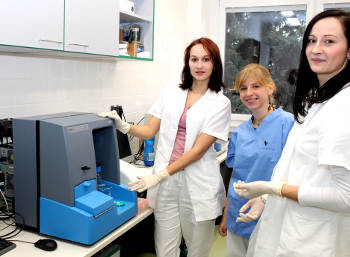Malvern Panalytical reports on how NanoSight's Nanoparticle Tracking Analysis, NTA, is being applied in the Veterinary Research Institute, Brno, Czech Republic in the research group of Dr. Jaroslav Turanek in the Department of Pharmacology and Immunotherapy).
The central theme of Dr. Jaroslav Turanek's research group (Department of Pharmacology and Immunotherapy) at the Veterinary Research Institute in Brno is to apply synthetic and bioorganic chemistry. This work is performed in collaboration with King's College London and the Institute of Organic Chemistry and Biochemistry, Prague, for the design and construction of therapeutic nanoparticles to develop drug delivery systems (anticancer and antiviral drugs) and nanocarriers for construction of recombinant vaccines.
 Users of the Malvern Panalytical NanoSight NS500 at the VRI, Brno in the Czech Republic.
Users of the Malvern Panalytical NanoSight NS500 at the VRI, Brno in the Czech Republic.
In parallel, the research group of Dr. Miroslav Machala (Department of Chemistry and Toxicology) at Veterinary Research Institute focuses upon environmental nanoparticulate pollutants. Characterization of airborne particles is conducted using electron microscopy, but in vitro tests on cell culture require knowledge of the real structure of nanoparticles in the tissue culture medium (e.g. aggregation). This enables the group to draw the correct conclusions from in vitro toxicological experiments which can be affected by differences in local nanoparticle concentration owing to sedimentation. Detailed particle distribution and kinetics of aggregation in this heterogeneous system is impossible to obtain using electron microscopy and hence Nanoparticle Tracking Analysis, NTA, is the method of choice. It is noted that some metastable aggregates can disaggregate due to high dilution of the sample required for NTA analysis. For this reason, Dynamic Light Scattering, DLS, and NTA are used as suitable complementary methods in the laboratory.
The Malvern Panalytical NanoSight NS500 system is used in the VRI laboratories as alongside other techniques including DLS (Zetasizer Nano ZS), static light scattering, Gel Permeation Chromatography, electron microscopy and Field Flow Fractionation.
Explaining their choice of NanoSight, Dr Turanek said "We chose NTA as a convenient and rapid method for characterization of nanoparticles in heterogeneous preparations like liposomes and their complexes with proteins, DNA and polysaccharides. A set of these techniques is used for the complex characterization of the structure of the nanoparticles, the kinetics of their preparation, the dynamics of morphological transformation and, finally, their stability. NTA perfectly fits our needs and has become a standard method in our methodological portfolio. The most advantageous feature of NTA is that it makes it possible to visualize each nanoparticle and then to obtain more detailed size distributions based on individual particle measurements. DLS is used as precise complementary method for the characterization of nanoparticles below 20 nm for proteins and other biopolymers. Combination of these two methods, NTA and DLS, with separation methods (GPC, FFF) and electron microscopy is preferred to get the full insight to structure and dynamics of nanoparticles in our sample systems."
At present the NanoSight system is also used for educational purposes at Masaryk University (practical courses in Nanotechnology).
To learn more about particle characterization using Malvern Panalytical's unique nanoparticle tracking analysis solutions, visit www.nanosight.com
About Malvern Panalytical
Malvern Panalytical provides the materials and biophysical characterization technology and expertise that enable scientists and engineers to understand and control the properties of dispersed systems. These systems range from proteins and polymers in solution, particle and nanoparticle suspensions and emulsions through to sprays and aerosols, industrial bulk powders and high concentration slurries. Used at all stages of research, development and manufacturing, Malvern Panalytical's materials characterization instruments provide critical information that helps accelerate research and product development, enhance and maintain product quality and optimize process efficiency. Our products reflect Malvern Panalytical's drive to exploit the latest technological innovations and our commitment to maximizing the potential of established techniques. They are used by both industry and academia, in sectors ranging from pharmaceuticals and biopharmaceuticals to bulk chemicals, cement, plastics and polymers, energy and the environment.
Malvern Panalytical systems are used to measure particle size and count, particle shape, zeta potential, protein charge, molecular weight, mass, size and conformation, rheological properties and for chemical identification, advancing the understanding of dispersed systems across many different industries and applications.
Headquartered in Malvern Panalytical, UK, Malvern Panalytical has subsidiary organizations in all major European markets, North America, Mexico, China, Japan and Korea, a joint venture in India, a global distributor network and applications laboratories around the world. www.malvern.com.
About NTA
"Nanoparticle Tracking Analysis" (NTA) detects and visualizes populations of nanoparticles in liquids down to 10 nm, dependent on material, and measures the size of each particle from direct observations of diffusion. Additionally, NTA measures concentration and a fluorescence mode differentiates suitably-labelled particles within complex background suspensions. Zeta potential measurements are similarly particle-specific.
This real-time data gives insight into the kinetics of protein aggregation and other time-dependent phenomena in a qualitative and quantitative manner. NTA has a growing role in biodiagnostics, being proven in detection and speciation of extracellular vesicles.